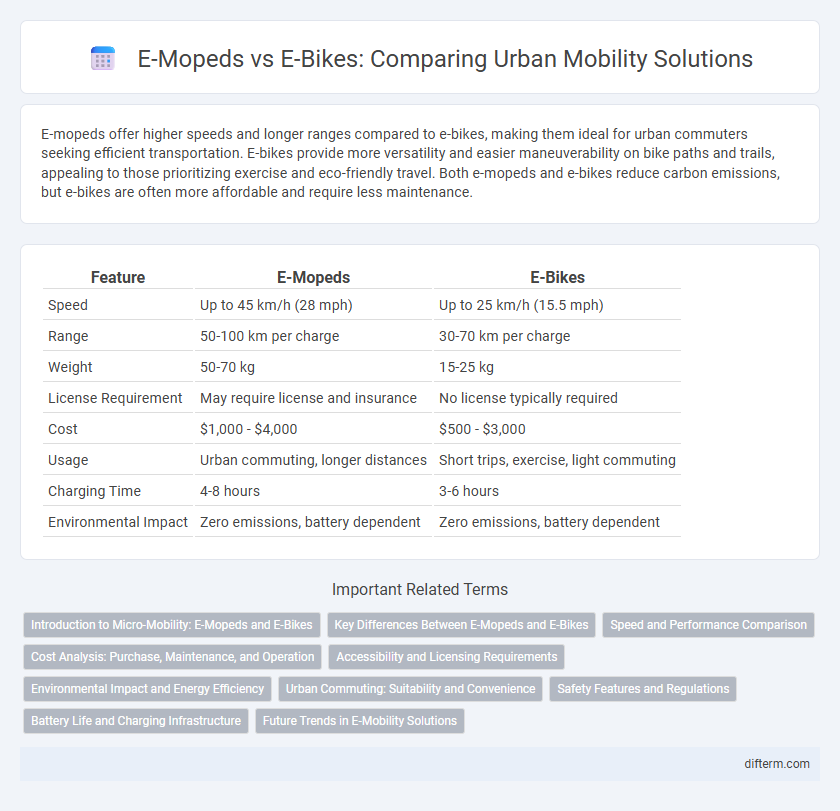E-mopeds offer higher speeds and longer ranges compared to e-bikes, making them ideal for urban commuters seeking efficient transportation. E-bikes provide more versatility and easier maneuverability on bike paths and trails, appealing to those prioritizing exercise and eco-friendly travel. Both e-mopeds and e-bikes reduce carbon emissions, but e-bikes are often more affordable and require less maintenance.
Table of Comparison
| Feature | E-Mopeds | E-Bikes |
|---|---|---|
| Speed | Up to 45 km/h (28 mph) | Up to 25 km/h (15.5 mph) |
| Range | 50-100 km per charge | 30-70 km per charge |
| Weight | 50-70 kg | 15-25 kg |
| License Requirement | May require license and insurance | No license typically required |
| Cost | $1,000 - $4,000 | $500 - $3,000 |
| Usage | Urban commuting, longer distances | Short trips, exercise, light commuting |
| Charging Time | 4-8 hours | 3-6 hours |
| Environmental Impact | Zero emissions, battery dependent | Zero emissions, battery dependent |
Introduction to Micro-Mobility: E-Mopeds and E-Bikes
E-mopeds and e-bikes represent pivotal advancements in micro-mobility, offering sustainable and efficient alternatives to traditional urban transportation. E-mopeds provide higher speeds and longer ranges, making them suitable for commuters covering moderate distances, while e-bikes emphasize pedal-assist technology that promotes health benefits and accessibility. Both vehicles contribute significantly to reducing urban congestion and carbon emissions, reshaping the future of short-distance travel in cities.
Key Differences Between E-Mopeds and E-Bikes
E-mopeds typically have higher speed capacities, often reaching up to 30-45 mph, compared to e-bikes which usually max out around 20-28 mph due to pedal-assist limitations. E-mopeds run primarily on a throttle without the need for pedaling, whereas e-bikes combine motor power with manual pedaling for extended range and exercise benefits. Legal distinctions and licensing requirements also differ, as e-mopeds often require registration and a driver's license, unlike many e-bike models categorized under bicycle regulations.
Speed and Performance Comparison
E-mopeds typically offer higher top speeds ranging from 28 to 45 mph compared to e-bikes, which usually max out between 15 to 28 mph, making e-mopeds more suitable for longer commutes and faster urban travel. The performance of e-mopeds is enhanced by more powerful motors, often between 500W and 1500W, whereas most e-bikes feature motors up to 750W, providing quicker acceleration and better hill-climbing ability. Battery capacity and weight also differ significantly; e-mopeds carry larger batteries to support extended range and higher speeds, while e-bikes prioritize lighter design for agility and ease of use.
Cost Analysis: Purchase, Maintenance, and Operation
E-mopeds typically have higher upfront costs, averaging $1,000 to $3,000 compared to e-bikes, which range from $500 to $2,500. Maintenance expenses for e-mopeds include battery replacement and motor repairs, often costing $100 to $300 annually, while e-bikes incur lower maintenance fees, around $50 to $150 per year. In terms of operation, e-mopeds consume more electricity due to larger batteries and higher speeds, resulting in increased energy costs compared to the more efficient e-bikes.
Accessibility and Licensing Requirements
E-mopeds offer greater accessibility due to their higher speed limits and often require a driver's license or specific permit, making them less accessible to younger or unlicensed riders compared to e-bikes. E-bikes generally have fewer licensing requirements and can be used by a broader age range, with many regions allowing operation without a license or registration. This difference in legal restrictions significantly impacts the choice between e-mopeds and e-bikes for urban mobility and first-mile/last-mile transportation.
Environmental Impact and Energy Efficiency
E-mopeds consume more energy per kilometer compared to e-bikes, resulting in a higher carbon footprint despite their faster speeds. E-bikes, powered by pedal assistance, optimize energy consumption with lower emissions and reduced battery demand, making them more environmentally sustainable. The production and disposal of larger batteries in e-mopeds also contribute to greater ecological impact compared to the smaller, lighter batteries used in e-bikes.
Urban Commuting: Suitability and Convenience
E-mopeds offer higher speeds and longer range, making them suitable for commuters covering greater distances or requiring faster travel times in urban settings. E-bikes provide more flexibility with easier maneuverability and lower operational costs, ideal for shorter trips and congested city streets. Both options enhance eco-friendly urban mobility, but choice depends on individual commute length, speed needs, and parking availability.
Safety Features and Regulations
E-mopeds typically offer enhanced safety features such as stronger frames, integrated lighting systems, and more robust braking mechanisms compared to e-bikes, aligning with stricter regulatory standards. Regulations for e-mopeds often require mandatory registration, insurance, and adherence to helmet laws, unlike many e-bike classifications that face less stringent compliance requirements. These differences ensure that e-mopeds conform to motor vehicle safety standards, contributing to safer urban mobility environments.
Battery Life and Charging Infrastructure
E-mopeds typically offer longer battery life ranging from 40 to 80 miles per charge compared to e-bikes, which average 20 to 50 miles, making e-mopeds more suitable for extended urban commutes. Charging infrastructure for e-mopeds is expanding rapidly with dedicated fast-charging stations, while e-bikes mainly rely on standard household outlets, limiting their quick recharge capabilities. Battery technology advancements in lithium-ion cells are enhancing energy density for both, but e-mopeds benefit more from standardized charging networks in metropolitan areas.
Future Trends in E-Mobility Solutions
E-mopeds are rapidly advancing with higher speed capabilities and extended battery life, making them viable alternatives for urban commuting and delivery services. E-bikes continue to dominate the micro-mobility market due to their affordability, ease of use, and integration with smart city infrastructure. Future trends indicate a convergence of IoT-enabled features, improved energy efficiency, and regulatory support that will accelerate widespread adoption of both e-mopeds and e-bikes in sustainable transportation ecosystems.
e-mopeds vs e-bikes Infographic

 difterm.com
difterm.com